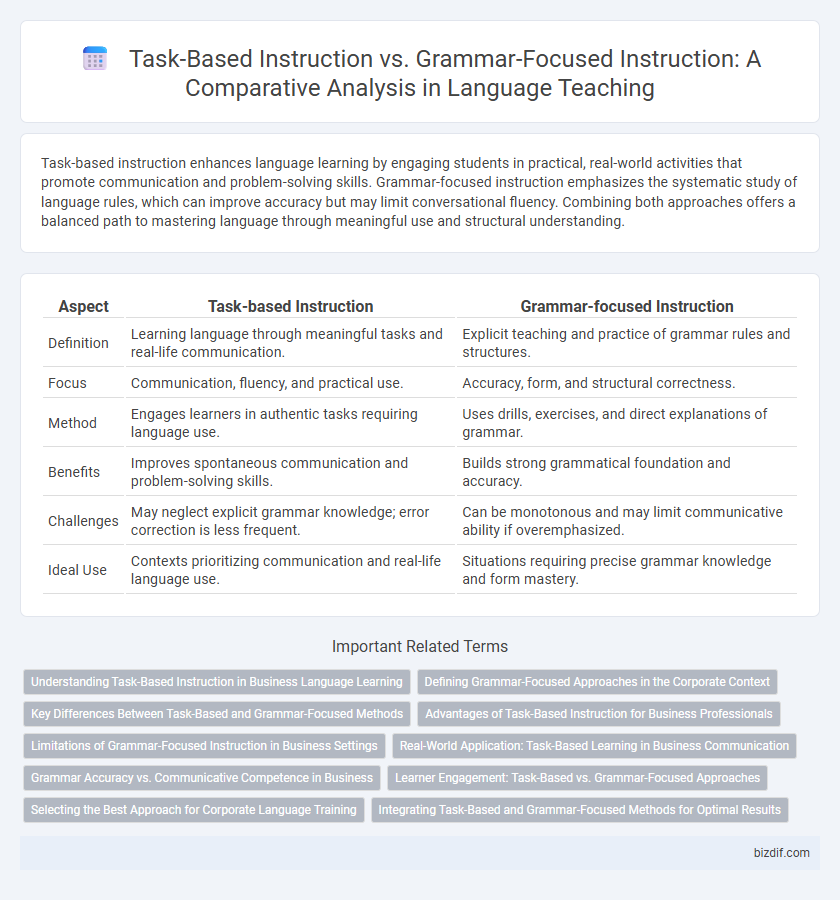Task-based instruction enhances language learning by engaging students in practical, real-world activities that promote communication and problem-solving skills. Grammar-focused instruction emphasizes the systematic study of language rules, which can improve accuracy but may limit conversational fluency. Combining both approaches offers a balanced path to mastering language through meaningful use and structural understanding.
Table of Comparison
| Aspect | Task-based Instruction | Grammar-focused Instruction |
|---|---|---|
| Definition | Learning language through meaningful tasks and real-life communication. | Explicit teaching and practice of grammar rules and structures. |
| Focus | Communication, fluency, and practical use. | Accuracy, form, and structural correctness. |
| Method | Engages learners in authentic tasks requiring language use. | Uses drills, exercises, and direct explanations of grammar. |
| Benefits | Improves spontaneous communication and problem-solving skills. | Builds strong grammatical foundation and accuracy. |
| Challenges | May neglect explicit grammar knowledge; error correction is less frequent. | Can be monotonous and may limit communicative ability if overemphasized. |
| Ideal Use | Contexts prioritizing communication and real-life language use. | Situations requiring precise grammar knowledge and form mastery. |
Understanding Task-Based Instruction in Business Language Learning
Task-based instruction in business language learning emphasizes practical communication skills by engaging learners in real-world business scenarios, such as negotiations or presentations, enhancing fluency and problem-solving abilities. This approach contrasts with grammar-focused instruction, which prioritizes the explicit teaching of grammatical rules but may limit learners' ability to apply language dynamically in workplace contexts. Research highlights that task-based learning improves retention and adaptability in business communication by aligning language practice with authentic professional tasks.
Defining Grammar-Focused Approaches in the Corporate Context
Grammar-focused instruction in the corporate context emphasizes the explicit teaching of syntactic rules and language structures to improve accuracy in professional communication. This approach targets specific grammatical competencies relevant to business writing, presentations, and formal correspondence, ensuring employees can produce error-free language in workplace interactions. By prioritizing controlled practice and error correction, grammar-focused methods enhance clarity and precision essential for corporate success.
Key Differences Between Task-Based and Grammar-Focused Methods
Task-based instruction centers on real-world communication through meaningful tasks, promoting language use in authentic contexts, while grammar-focused instruction emphasizes explicit teaching and practice of grammatical rules. Task-based methods prioritize fluency and pragmatic competence, encouraging learners to negotiate meaning, whereas grammar-focused approaches target accuracy and structural understanding through controlled exercises. The key difference lies in their objectives: task-based instruction fosters communicative competence and learner autonomy, whereas grammar-focused instruction aims for mastery of form and rule-based proficiency.
Advantages of Task-Based Instruction for Business Professionals
Task-Based Instruction enhances business professionals' language skills by emphasizing practical communication through real-world tasks, promoting fluency and confidence in workplace interactions. This approach improves problem-solving and collaboration abilities by simulating authentic business scenarios, leading to more effective negotiation and presentation skills. Unlike grammar-focused instruction, Task-Based Instruction fosters meaningful language use, accelerating language retention and adaptability in dynamic business environments.
Limitations of Grammar-Focused Instruction in Business Settings
Grammar-focused instruction often falls short in business settings due to its limited emphasis on practical communication skills and real-world application. Learners may struggle to engage in authentic interactions or solve workplace problems effectively when language use is taught through isolated grammatical rules. This approach restricts the development of fluency and adaptability, which are critical for dynamic business environments.
Real-World Application: Task-Based Learning in Business Communication
Task-based instruction enhances real-world application by engaging learners in authentic business communication tasks such as presentations, negotiations, and email correspondence. This approach prioritizes practical language use over isolated grammar rules, fostering fluency and contextual understanding. Research shows task-based learning improves communicative competence and confidence in professional settings better than traditional grammar-focused instruction.
Grammar Accuracy vs. Communicative Competence in Business
Task-based instruction in business language training enhances communicative competence by simulating real-world scenarios that prioritize message clarity and practical interaction skills. Grammar-focused instruction emphasizes accuracy, ensuring that business professionals produce error-free language critical for formal communications and documentation. Balancing task-based activities with targeted grammar practice optimizes both fluency and precision essential for effective business communication.
Learner Engagement: Task-Based vs. Grammar-Focused Approaches
Task-based instruction enhances learner engagement by involving students in meaningful, real-world activities that promote active communication and problem-solving. Grammar-focused instruction often centers on explicit rules and drills, which may limit interaction and reduce motivation. Research indicates that learners participating in task-based methods exhibit higher motivation and sustained interest compared to those in traditional grammar exercises.
Selecting the Best Approach for Corporate Language Training
Task-based instruction enhances corporate language training by emphasizing practical communication skills through real-world tasks, fostering employee engagement and fluency development. Grammar-focused instruction systematically builds foundational language accuracy, which is essential for formal business communication and ensuring clarity in corporate settings. Selecting the best approach depends on organizational goals, with task-based instruction suited for dynamic, interactive roles and grammar-focused methods ideal for environments requiring precise language use.
Integrating Task-Based and Grammar-Focused Methods for Optimal Results
Integrating task-based instruction with grammar-focused methods enhances language acquisition by combining meaningful communication practice and precise grammatical understanding. Task-based learning promotes real-life language use through authentic activities, while grammar-focused instruction ensures accuracy and structural competence. Combining these approaches results in balanced language proficiency, enabling learners to communicate effectively and correctly.
Task-based instruction vs Grammar-focused instruction Infographic

 bizdif.com
bizdif.com